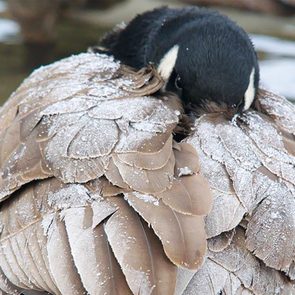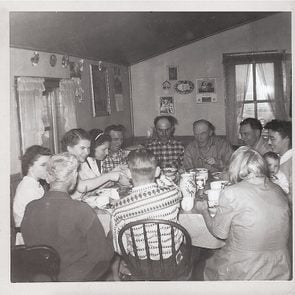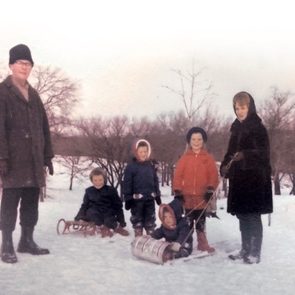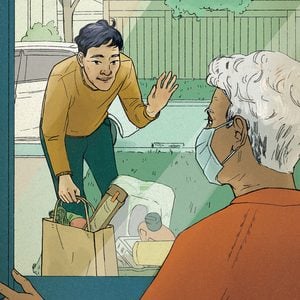Mastering Silhouette Photography
From spring through fall, when nature is in her prime, I dedicate at least one day a week to taking photos of the wild birds that congregate at Crescent Lake here in Portage la Prairie. This labour of love allows me to enjoy our milder, though very brief, Canadian seasons. It also adds to my ever-growing toolbox of photography skills. I have found playing with light and shadow to be a very rewarding study. Our wild subjects are often guaranteed to walk, swim or fly directly into locations where the available light is less than ideal, and all the visible details we wish to capture become lost. This is where you can get creative and start working with available shade.
A silhouette is defined as a dark shape and/or an outline of a subject visible against a lighter background, especially in dim light.
I photograph birds when the sunlight is behind them—directly or not—muting out most details on the front of the animals, creating a silhouette. The lighter backgrounds such as the colourful sky or surrounding water, are purposely either completely blank, or have a minimum of distractions, so as to not take focus off the darkened subjects. I naturally include the birds’ environments to add interest, be it the kingbird’s perch in the branches, or the ducks’ own reflections in the lake.
Many photographers agree that the best times to take nature photos are in early morning, after sunrise, or in the late afternoon towards sunset. Not only is wildlife most active then, but sunrises will often give off an ambience of cool blue to pink hues, whereas sunsets can reward our shots with a magical golden glow.
Working with available shade will help you to create some stunning silhouettes when photographing nature, especially when optimal light conditions are lacking. Keep adding to your own toolboxes of photography skills, folks!
Next, check out these 5 ways to take better black-and-white photos.
Several years ago, just a week before Christmas, my sister Phyllis acquired a new oven. Her 20-year old cooker had begun to wheeze ominously every time she swivelled the control knobs, so an upgrade was in order. The new stove was state-of-the-art. It had a built-in microwave oven, a convection oven and an electronic pad with sensors that buzzed discreetly, lights that blinked, and pale green displays that told you everything short of the next day’s weather forecast.
Christmas Day in our family followed a pattern. After morning church service, my sister and her husband, Derek, joined my parents, my husband, our two kids and me for a festive brunch at our house.
After the ritual of unwrapping the gifts stacked under our Christmas tree, Phyllis and Derek would usually scurry off home to get the turkey into the oven, so that it cooked in time for our Christmas dinner get-together at their home.
We had friends from Britain spending Christmas with us that year and after brunch, we watched the Queen’s Christmas message on TV and then lounged around, chatting. My sister seemed in no rush to get home.
“What about the turkey?” I asked her.
She threw me a smug glance. “No problem! The oven automatic timing thingy is on, and right now that little ol’ bird is sizzling and bubbling away in its juices.” She waved an airy hand. “Relax, kiddo!”
At 4:30 p.m. we all drove over to Phyl and Derek’s home. Noses twitching with anticipation we walked in the front door. But alas, no aroma of cooked turkey greeted us. Phyllis’ face went the colour of bleached paper. “Oh no!” She wailed. She opened the oven door and, yes, you guessed it! The turkey sat there pink, pimply and stone cold.
The doorbell rang. In surged more family including Phyllis and Derek’s children, their spouses and kids. “Merry Christmas!” the grandchildren yelled, throwing their arms around everyone. My sister, her expression still registering unprintable thoughts about her gleaming new stove, hugged them distractedly.
Oven coaxed to life, tree denuded of gifts and bar opened for all takers, my sister poured herself a glass of wine. The children, supplied with generous amounts of Christmas cookies, candies, pop and chips, disappeared into the basement, whooping gleefully, to play with their new toys.
The rest of us, fortified with rum punch, eggnog, brandy, ginger wine and other assorted libations, gathered around the piano to sing Christmas carols. When we ran out of carols, we belted out show tunes, and sing-along favourites, or ribald versions of campfire songs.
Our English visitors, also happily lubricated, joined the act. Digby recited the monologue “The Lion and Albert” a-la Stanley Holloway. His wife, Sarah, had a go at Carmen Miranda: “Ay-yi-yi-yi love you verrry much,” she warbled, swivelling her hips and rolling her eyes. My sister, who by then was past caring about the turkey, blasted her way through a Liza Minnelli impersonation of “New York, New York.”
The grandchildren, drawn by the sounds of adult merriment, came upstairs and were co-opted into an uproarious, if rather tipsy, game of charades. Between acts we consumed nuts, chocolate mints, shortbread cookies, Christmas cake and spicy Mexican tacos. A platter of cold cuts and cheese disappeared faster than a con on the lam.
The turkey finally emerged from the oven around midnight. By then, we’d “boom-si-daisied” done the Lambeth Walk and taken a stab at the Can-Can. Music turned up several decibels, we’d also jived, done the cha-cha, the limbo rock and the Macarena twice over.
“Yoo-hoo! Dinner is served,” my sister called out, beating an empty can with a spoon. Her announcement was drowned out by a lusty “one-two-three and a kick” as we conga’d through the living room, caterpillared our way into the dining room, and circled the table three times before being prevailed upon to please sit down!
Our friends from England send us Christmas cards every year. The last one had a note saying that if Phyllis promised to use her high-tech stove again, they’d be back here—faster than a Canadian turkey takes to cook.
Next, check out this tale of how the family dog helped save the Christmas pudding.
Every Christmas, our mother told us the tale of the year the family dog acquired a sweet tooth. It was 1950 and she was a new bride who had married into a family of good cooks.
A long wooden table covered in white linens was set for the Christmas feast. Steam rose from freshly whipped potatoes. On a large platter, roasted turkey sat ready to be carved. The aroma of stuffing warming in the oven filled the country kitchen. Pickled beets from the cold cellar sat in decorative dishes. One by one the relatives gathered, calling out festive greetings.
In the kitchen, my mother huddled by the wood stove. She stood alone with her anxious thoughts. She looked towards the back door. In the middle of a Canadian winter, despite the lake-effect snow, my mother was sweating. Turning, she glanced at a recipe card yellowed with age. It was for a rich pudding sauce that had been handed down from one generation to the next over the years—one wrong move meant certain disaster.
Although Mom was courageous, she had travelled alone from rural Ontario to Toronto at the age of 17 to earn her teaching certificate—this was different. This was “the pudding!” This was “the sauce!” This was “the tradition!” And these were the relatives she had to impress.
She stared into the bottom of the aluminum pot. Her hand moved to the canister of brown sugar; her eyes darting back to the recipe card stained in gravy drippings. “Half a cup,” she said to herself. A ceramic bowl, chipped and worn, contained the perfect measurement of corn starch. A tea kettle whistled as steam rose to the ceiling. The caramelizing of the sauce required full concentration. “Check the temperature of the stove,” she whispered. “Water first! Heat and stir. Slowly add the starch!”
A Dog’s Dinner
The dog barked from the other side of the door. “It should have thickened by now,” my mother muttered to herself. “Something is wrong!” The clock on the china cabinet chimed. “Damn!” my mother muttered under her breath. She usually didn’t swear. She stuck her head out into the frigid air to cool off. The Christmas banquet was almost ready—no time to over think things.
The dog smiled up at her. Lowering the pot, she poured the ruined sugary liquid into his dented food dish. Without wasting any time, she headed back inside. With her usual determination she tried again. Once more, the sauce refused to thicken.
The dog feasted on ruined sauce twice more—Mom’s failures had become the canine’s pathway to the good life. He hadn’t had it so good since a bunch of potatoes had gone dry the previous summer.
Finally, as suspicions were rising in the crowded dining room—the sauce thickened. The pudding, steaming in a kettle nearby, let out a puff of approval.
My mother wiped her brow on the corner of her apron. Removing the covering, she calmly sat down to Christmas dinner. Outside the back door, the dog snored. He moaned in his sleep, as though enjoying sweet dreams.
Next, check out what a country Christmas was like in the 1950s.
A few years after the death of my dad, Basil O’Keefe, my mom moved away from the family farm near Almonte, Ontario, into her first apartment. She was 82. As a family, we thought it would be easier for her not to have to drive for groceries and appointments, and she would also be closer to her sister and friends. We were also concerned that she was spending too much time on her own and hoped that this move would widen her social circle.
As she and I sorted through her belongings in preparation for the move, Mom shared with me all kinds of stories about her and my father’s life together. We missed him terribly.
Once we were done, we drove in to town and left the discarded belongings at The Hub—Almonte’s secondhand store—so that they could be resold and the money would go to charity.
A week later, we opened up our local paper and there in black and white was a four-by-six-inch photo of my father, with a story to accompany it.
A local gentleman had gone to The Hub and bought one of Mom’s old suitcases. When he went through the suitcase at home, he found a black-and-white negative inside a tattered envelope with the word “Daddy” written in pencil on the front.
Knowing that this photo certainly meant something to someone, he took it to the Almonte Gazette and asked if they would publish it in order to return the negative to its rightful owner. The paper did just that and their story asked readers to contact them if they knew who “Daddy” was. Immediately, the calls starting coming in fast and furious; readers knew the man in the picture. It was their brother, their uncle, their brother-in-law, their neighbour, their friend, their cousin, their favourite bus driver. The staff at the Gazette were astonished by the response.
Mom and I went to the Gazette right away to claim our negative and thank the staff for taking such good care of it. They also gave us the name of the man who had found the negative, and we called him and thanked him for reuniting Mom, Daddy and me.
The small town of Almonte really did go that extra mile for us and we sure appreciated it. The move wasn’t easy on either of us and we were always second-guessing whether it was the right decision. The fact that a complete stranger was willing to take the time to return that one little negative meant the world to us. We really believed that it was Daddy’s way of telling us everything would be okay.
Mom eventually moved into a nearby nursing home. She passed away in November 2017, at 97, and until then hardly a day went by that she did not look at, in her words, “that famous picture of Daddy,” on her bedside table.
Next, check out more extraordinary real-life stories about the kindness of strangers.









